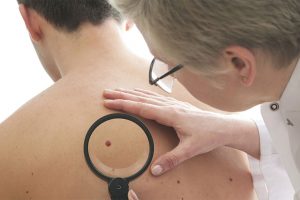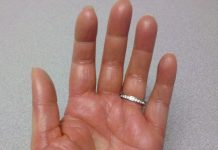There are a variety of skin cancers; some of the symptoms involve a change in the skin colour, ulcers the skin, change in the existing moles (enlarged moles, jagged edges moles, etc.) and bruised the skin. Let us know about skin cancer, in this article you will know types of skin cancer, risk factors for skin cancer and five signs and symptoms of skin cancer.
-
Types of Skin Cancer
Before going into detail about skin cancer you need to know about a normal mole on your skin. A normal mole is a small brown spot or growth that appears in the first few decades of life. It can be flat or raised and generally is round. There are mainly three types of skin cancers, below discussed are the types.
- Basal Cell Carcinoma: Lump clear and shiny, dark brown or wound that looks like meat evenly.
- Squamous cell carcinoma: Reddish spots are seen on the skin that feels soft when touched; the wound becomes dry and scaly or crusty flat shape. Persistent bleeding is common with this rarely deadly cancer, wart, scaly, patches open sores and rapidly bumps are telltale signs.
- Melanoma: The patches on the skin can become wide with a darker colour than the surrounding, moles that change the size and colour, spots such as scars with uneven edges, the colour of the spots may be red, white, black, blue spots on the palms and back of the hands. You can also see them on fingers, toes, or mucous membranes news around the mouth, nose vagina and anus.
-
Risk Factors of Skin Cancer
- History of Melanoma: A person, who has already had a malignant melanoma or non-melanoma skin cancer, is at much higher risk of another skin cancer, because of lifetime exposure to UV radiations.
- Sunlight (UVR) Exposure: Risk comes from both natural and artificial sources such as tanning booths.
- Moles: Irregular, dysplastic or multiple nevi increase risk.
- Fair Skin: People with fair skin, freckles or red or blond hair have a higher risk of malignant melanoma or non-melanoma skin cancer. Persons with red hair have the higher risk.
- Family History: Approximately 10% of people with melanoma have a first degree relative with malignant melanoma.
- Weakened Immune System: People who have been treated with medicines that suppress the immune system, such as transplant patients, have an increased risk of developing both malignant melanoma and non-melanoma skin cancer.
- Age: Risk is higher with ageing, but malignant melanoma may occur in younger people.
- Gender: Men have a higher rate of malignant melanoma and non-melanoma skin cancer than women.
-
Signs and symptoms of skin cancer
- Asymmetry: Most early melanomas are asymmetrical; line through the middle would not create matching halves. Common moles are round and symmetrical.
- Border: The borders of early melanomas are often uneven and may have scalloped or notched edges. Common moles have smoother more even borders.
- Colour: Common moles usually are a single shade of brown. But moles with various shades of brown, black or tan are often the first sign of melanoma. As melanoma growth increases, the colour change may appear, it will be blue, red or white.
- Diameter: The diameter of the melanoma tends to grow larger than common moles, during the early melanoma. (about 6mm or ¼ in diameter)
Evolving: When a mole starts to evolve or change, see your dermatology practitioner. If you have any signs and symptoms, like increased size, change in colour and shape or if you find symptoms such as itching, bleeding; is a sign or danger.














